High Lipase Milk and How to Fix It
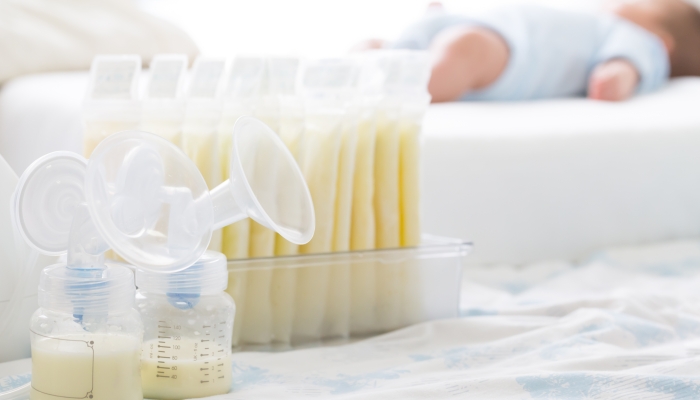
- Lipase is an important enzyme found in all breast milk that helps digestion.
- High lipase may cause changes to the smell and taste of breast milk.
- High lipase is not uncommon and it will not hurt your baby.
- Scalding breast milk can fix high lipase and prevent changes in stored breast milk.
Being able to pump and store your breast milk is a convenient option for busy moms. But sometimes babies may refuse to drink breast milk or you might notice a change in smell after milk has spent some time in the fridge. When this happens, it could be due to high lipase breast milk.
High lipase breast milk is common and won’t cause any harm to your baby. If your baby is refusing your milk, though, you’ll want to do something about it. Find out exactly what high lipase milk is and steps you can take to fix it.
What Is Lipase?
Lipase is what our body uses to digest fats. These digestive enzymes are made in places like the glands in our mouth, our stomach, and an organ called the pancreas. Lipase helps us break down the fats in the food we are eating. This makes it so our body can use them more easily.
All types of milk contain lipase. Lipase in breast milk is very important to your child’s digestive health because it:
- Helps your child digest the fats in the milk.
- Allows the fats in the milk stay mixed into the milk.
- Breaks down fatty acids that can support health and immunity.
Everyone’s body produces lipase, and all breast milk has lipase in it. It’s like the nutrition in breast milk comes with a partner—that partner is the lipase and it all comes in one package.
Inside breast milk, we have vital nutrients like fats. The lipase is there to release fat soluble nutrients and help the milk be digested more easily.
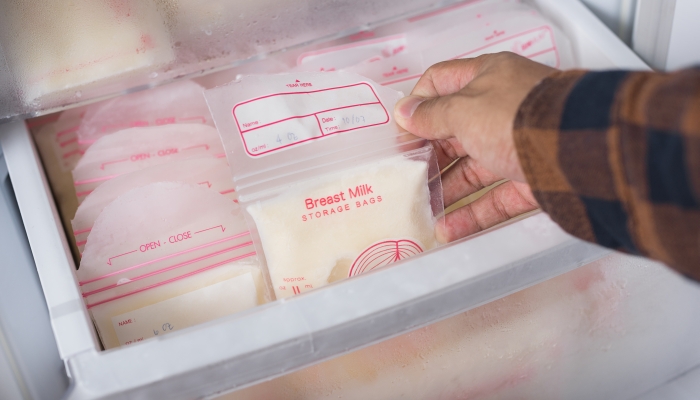
The Cause and Impact of High Lipase in Breast Milk
Like we are all individuals, so is the breast milk we make. Your breast milk will have a different taste and smell than someone else’s. It will also have different amounts of lipase activity compared to others.
If your breast milk is high in lipase this doesn’t mean anything is wrong with you. It also doesn’t mean there is anything wrong with your milk. Excess lipase in your breast milk doesn’t mean you did something wrong, and it’s not something you need to work on fixing.
You may notice more differences in high lipase milk that’s been pumped and stored than in freshly expressed milk. For example, breast milk with high lipase that has been stored can develop a soapy smell. Others have also described high lipase milk as having a fishy or metallic smell.
The main reason for the change is the time that has passed while the milk is stored. Time allows the lipase to do what it was intended to do, which is breaking down the fats. As the fats are broken down, one of the changes that you’ll notice is a change in smell.
In freshly pumped milk fed to the baby, the lipase doesn’t have much time to break down the fats in the milk before it’s ingested. That is why high lipase milk smells normal at first. When milk is pumped, and then stored—even when it is stored properly—over time the changes to taste and smell become noticeable.
Your baby can recognize the unique taste and smell of your breast milk. This brings about the main challenge with excess lipase in breast milk. As time passes, the changes in smell and taste are why some babies refuse to drink milk that has been stored. This may be difficult for those mothers needing to return to work, or those moms that need to pump and store milk for feeding.
For those mothers who may combine breastfeeding and pumping or may only be pumping, this isn’t something to feel bad about. What’s important to know is that the longer the breast milk is stored, the longer the lipase activity will be allowed to continue.
The longer the lipase breaks down the fats in the milk, the greater the chance there will be changes in the taste or smell of the milk. This means that high lipase milk can still be fed to your baby—you will just need to think about the timing.
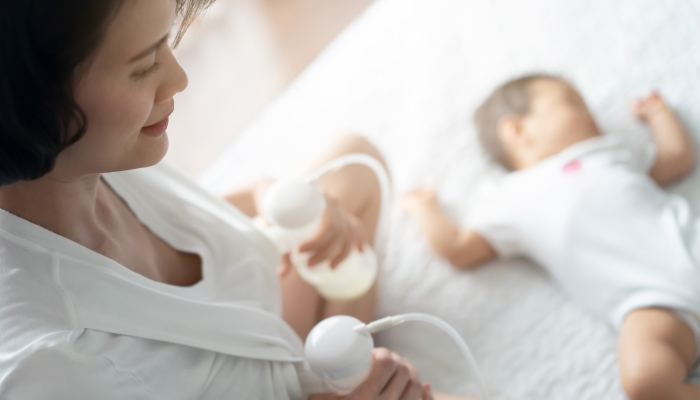
Is High Lipase Milk Bad for Babies?
Having excess lipase activity in your breast milk is not uncommon and is not something to be upset about. Sure, it may make your pumping and storage process a little more complicated but it’s certainly no tragedy.
Lipase won’t impact the nutritional benefits of the milk. High lipase in your breast milk will not harm your baby or impact your baby’s health.
The changes to the taste and smell of the milk can make you worry, but as long as your freshly pumped breast milk is stored properly, it’s safe and your baby will not have any problems digesting it.
How to Tell if Your Milk Is High in Lipase
The first step in determining if your milk is high in lipase should be to rule out any other causes of the changes. If you are noticing changes in the smell or taste of your breast milk you should first rule out any concerns that the milk may have spoiled.
Follow breast milk storage guidelines.
Making sure that you’re following proper breast milk storage guidelines is the best way to make sure that the reason for the changes in smell or taste is not because the milk may have possibly gone bad.
Using proper breast milk storage containers that are clean is very important. You should also store the milk at recommended temperatures inside the recommended time frames.
Being familiar with proper breast milk storage guidelines includes knowing how long warmed breast milk is good for and how long milk can be in the refrigerator or freezer. It also includes firm recommendations on not refreezing thawed breast milk.
Be sure to follow these breast milk storage guidelines:
- Don’t let freshly expressed or pumped milk sit out for more than 4 hours.
- Don’t let thawed milk sit out for more than 2 hours.
- Refrigerated milk needs to be used within 4 days.
- Frozen milk is good for 6 to 12 months.
- Don’t refreeze thawed milk
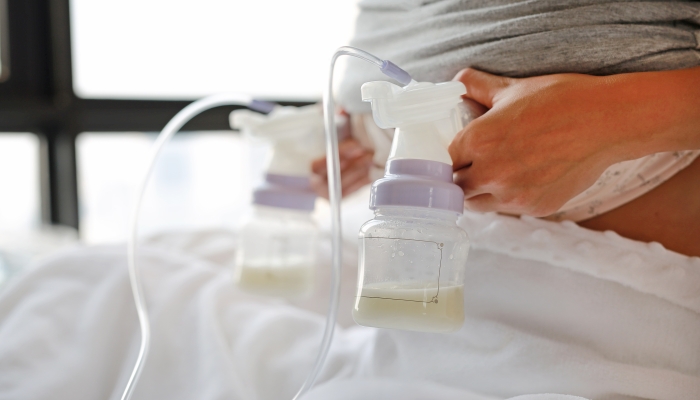
Do a smell test with freshly pumped milk.
After ruling out any potential for your milk to be going bad, you can start working on figuring out if excess lipase is the reason for a change in your breast milk. The most common way to tell if your milk is high in lipase is to check for changes in smell under proper storage conditions.
One way to do this is to check the milk while it’s stored in the refrigerator. Here’s how:
- First, smell the milk at the beginning of storage.
- Then pick a number of hours before you will smell it again. Some people may check the milk every two hours, while others might choose a longer time frame.
- Keep track of how many hours pass when you notice a change. You should also do this a couple of times so you can see a consistent timeline for the changes to the smell of the milk.
Checking frozen breast milk for changes.
For those that freeze stored breast milk, this method can be done with frozen milk as well. Lipase activity does not stop just because the milk has been frozen.
Because frozen milk is stored for longer you may want to check the milk with a longer time frame between checks. For example, you may smell the milk on a weekly basis and check for changes in smell. This should include only milk stored within the recommended time frame of 6 to 12 months.

How to Fix High Lipase Breast Milk
If you find that you have high lipase breast milk, there are a couple of options to try so you can continue to feed your baby stored breast milk. These include using up any stored milk before changes happen or scalding the milk.
Use stored milk before changes occur.
The timing of the changes while the milk is being stored can be helpful for future feedings. The changes from excess lipase are going to be different from person to person. Changes may be noticeable quickly for some women, while others may take a couple of days.
Knowing the timeline for how long it takes for changes in the smell to happen can be helpful. It can tell you how long you can store your milk before you should feed it to your baby. If you notice your milk starts to smell different on day three of being stored in the refrigerator, it would make sense to use that milk on day one or two.
If your breast milk has high lipase, the easiest option would be to use any stored milk before the baby would notice any changes.
Scald freshly expressed milk.
For some women with high lipase breast milk, changes in the smell and taste of properly stored milk can happen very quickly. Sometimes it happens within a couple of hours. When the changes are happening that quickly, the method of timing the changes in stored milk isn’t really a great option.
For women with excess lipase that changes stored breast milk quickly, the best option may be to remove the possibility of any changes before the fresh milk is stored. A common method for doing this is called scalding the milk.
To scald milk, it’s heated to a temperature of 180 degrees Fahrenheit. The heat removes the enzyme activity of the lipase so it doesn’t break down the fats during storage. If the fats aren’t being broken down, the changes in smell and taste will not happen.
The scalding method and deactivating the lipase takes a couple of steps:
- Using a clean pan or pot place the expressed breast milk on low heat.
- Heat the milk until you see small bubbles forming around the edges, but do not boil the milk.
- Remove the milk from heat and place the pan inside another larger container filled with ice or cold water to quickly cool it.
- The milk can then be stored using proper breast milk storage guidelines
It’s important to not let the milk get too hot when scalding milk to keep the nutritional benefits of breast milk.
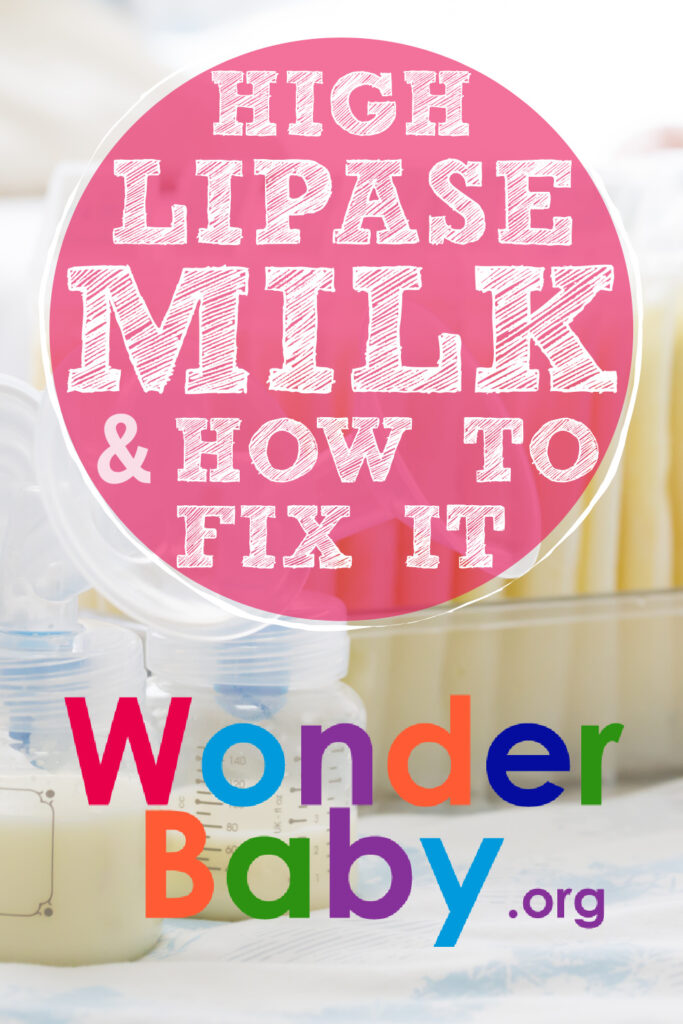
The information WonderBaby provides is not intended to be, and does not constitute, medical or other health advice or diagnosis and should not be used as such. Always consult with a qualified medical professional about your specific circumstances.
Related Posts

Breastfeeding, Sleep
Sleep and Breastfeeding: A Comprehensive Guide for Nursing Moms
Many people assume breastfeeding and sleep training don’t go together, but it is possible to help your baby sleep better while continuing your breastfeeding journey.

Breastfeeding
Comfort Nursing: Pros, Cons, and How to Stop
Find out what comfort nursing is, when should you worry about it, and how to stop or limit your baby's comfort nursing (especially at night!).

Breastfeeding, Product Reviews
5 Best Breastfeeding Chairs for Nursing Moms of 2023
Whether you want a gentle rock, a smooth glide, or a cozy cuddle to soothe your baby to sleep, you’ll have your pick of the best breastfeeding chairs on the...